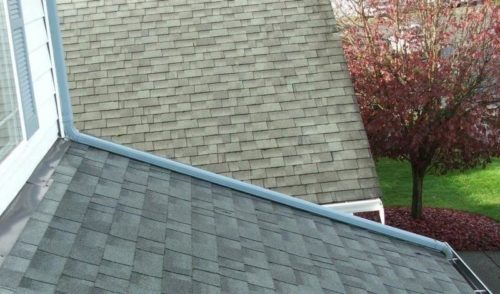
It is very common for dormers and other roof structures that have gutters above the level of the gutters on lower portions of the roof, to empty onto the roof surface. The water is allowed to run on the roof surface and is collected by the lower gutters.
In this first picture one can see where the gutter has been cut off at the same pitch as the roof to let the gutter empty onto the roof surface. Note also that the valley also sheds its water down the roof surface as well—-as opposed to into the gutter.

This is pretty normal for a valley and there is no real alternative. When we add the water from the gutter at the same point it results in a lot of water running over the roof surface in a concentrated area that causes that portion of the roof to age prematurely—-as well as impact siding on the dormer. It can also maintain moisture on the roof resulting in more moss growth.
In this next picture we can see where the water is drained the other direction to a downspout that then empties onto the roof surface.

How about this one with the additional problem the roof step flashing not being properly counter-flashed by the siding? Water flooding from this downspout can easily find its way into the roof and wall structures.

Leaving the gutters off altogether is not usually a good option (unless the roof is very, very small) because the rain dripping off the edge will wear on the roof below. Everyone has seen the holes that can be eaten into the ground below roofs with no gutters—-you don’t want this to happen to the ground around your foundation and the same kind of pounding can take a tole on a roof below other sections of roof with no gutters.

So what are better alternatives?
One common solution which most people don’t like because it is considered “unsightly,” is to make the downspout continuous over the surface of the roof. Besides being unsightly they are always getting stepped on or otherwise damaged—-but still a better solution than just letting the water run across the roof.

This has been a long-winded way of getting to perhaps the best solution to this problem that I have ever seen (as long we are going to insist on continuing to use asphalt shingles as a means of covering roofs).

This metal tray protects the roof surface, is not easily damaged by klutzy inspectors, and gets the water to the lower gutter—and won’t clog with debris.
Now if I could just talk people into covering the whole roof with the stuff.
***
Charles Buell, Real Estate Inspections in Seattle
If you enjoyed this post, and would like to get notices of new posts to my blog, please subscribe via email in the little box to the right. I promise NO spamming of your email